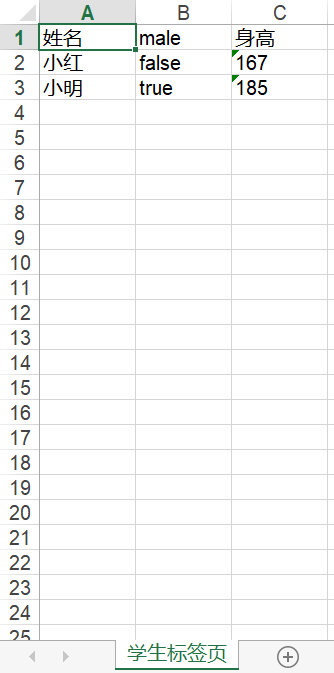标签:amp 新建 标签页 length png html 实现类 学生 href
Apache POI - the Java API for Microsoft Documents,顾名思义,Apache的三方包,用来操作微软office文档的,多数时候用来操作excel,所以这里就以excel方面来说明。
需要引入两个包,maven地址如下(version 3.9):
<dependency>
<groupId>org.apache.poi</groupId>
<artifactId>poi</artifactId>
<version>3.9</version>
</dependency>
<dependency>
<groupId>org.apache.poi</groupId>
<artifactId>poi-ooxml</artifactId>
<version>3.9</version>
</dependency>
POI的组件列表中,针对excel的主要是HSSF和XSSF组件,前者针对97-2007的通用版excel,即后缀xls;后者针对2007或更高版的excel,即后缀xlsx。官方概要如下:
HSSF is the POI Project‘s pure Java implementation of the Excel ‘97(-2007) file format.
XSSF is the POI Project‘s pure Java implementation of the Excel 2007 OOXML (.xlsx) file format.
面向对象面向对象,既然如此,自然去找找一些能表示excel中内容的类。
创建或维护Excel工作簿的所有类的超接口,Workbook,属于org.apache.poi.ss.usermodel包。其下有两个实现类:
所以在针对不同版本的excel时,需要对应以上使用不同的Workbook。构造函数中,常用的:
HSSFWorkbook
HSSFWorkbook()
HSSFWorkbook(java.io.InputStream s)
XSSFWorkbook
XSSFWorkbook()
XSSFWorkbook(java.io.File file)
XSSFWorkbook(java.io.InputStream is)
HSSFSheet 和 XSSFSheet 都是Sheet接口的实现类,Sheet可以使用Workbook的两个方法获得:
workbook.createSheet();
workbook.createSheet(String sheetName);
同理,Row是 HSSFRow 和 XSSFRow 的接口,通过Sheet获取:
sheet.createRow(int rownum);
同理,Cell是 HSSFCell 和 XSSFCell 的接口,通过Row获取:
row.createCell(int column);
row.createCell(int column, int type);
其实如果能理解面向对象,就很简单了,另外包括字体,公式,超链接等,都有对应的封装类,此处只提出了核心的几个,需要了解更多的需要自行展开。
例子的话,直接从别人教程里摘出来吧,另,读取的workbook,可以debug瞅瞅内容。
import java.io.*;
import org.apache.poi.xssf.usermodel.*;
public class CreateWorkBook
{
public static void main(String[] args)throws Exception
{
XSSFWorkbook workbook = new XSSFWorkbook();
FileOutputStream out = new FileOutputStream(
new File("createworkbook.xlsx"));
workbook.write(out);
out.close();
System.out.println("
createworkbook.xlsx written successfully");
}
}
import java.io.*;
import org.apache.poi.xssf.usermodel.*;
public class OpenWorkBook
{
public static void main(String args[])throws Exception
{
File file = new File("openworkbook.xlsx");
FileInputStream fIP = new FileInputStream(file);
XSSFWorkbook workbook = new XSSFWorkbook(fIP);
if(file.isFile() && file.exists())
{
System.out.println(
"openworkbook.xlsx file open successfully.");
}
else
{
System.out.println(
"Error to open openworkbook.xlsx file.");
}
}
}
可用注解定义标签名和列名,写了个方法,可以将某个类的List转换为对应的Excel文档,列名如果在不使用注解的情况下默认为属性名:
类:
@Excel(name = "学生标签页")
public class Student {
@Excel(name = "姓名")
private String name;
private boolean male;
@Excel(name = "身高")
private int height;
public String getName() {
return name;
}
public void setName(String name) {
this.name = name;
}
public boolean isMale() {
return male;
}
public void setMale(boolean male) {
this.male = male;
}
public int getHeight() {
return height;
}
public void setHeight(int height) {
this.height = height;
}
}
测试方法:
public static void main(String[] args) {
List<Student> list = new ArrayList<Student>();
Student student1 = new Student();
student1.setName("小红");
student1.setMale(false);
student1.setHeight(167);
Student student2 = new Student();
student2.setName("小明");
student2.setMale(true);
student2.setHeight(185);
list.add(student1);
list.add(student2);
File file = new File("C:/Users/Dulk/Desktop/1314.xls");
createExcel(list, file);
}
输出结果:

注解:
import java.lang.annotation.Retention;
import java.lang.annotation.RetentionPolicy;
@Retention(RetentionPolicy.RUNTIME)
public @interface Excel {
public String name() default "";
}
方法:
import org.apache.log4j.Logger;
import org.apache.poi.hssf.usermodel.HSSFWorkbook;
import org.apache.poi.ss.usermodel.Cell;
import org.apache.poi.ss.usermodel.Row;
import org.apache.poi.ss.usermodel.Sheet;
import org.apache.poi.ss.usermodel.Workbook;
import org.apache.poi.xssf.usermodel.XSSFWorkbook;
import java.io.File;
import java.io.FileInputStream;
import java.io.FileNotFoundException;
import java.io.FileOutputStream;
import java.io.IOException;
import java.io.InputStream;
import java.io.OutputStream;
import java.lang.reflect.Field;
import java.lang.reflect.InvocationTargetException;
import java.lang.reflect.Method;
import java.util.ArrayList;
import java.util.List;
public class ExcelUtil {
private static Logger log = Logger.getLogger(ExcelUtil.class);
public static Workbook gainWorkbook(File file) throws ExcelException {
if (!isExcel(file)) {
throw new ExcelException("文件不是Excel类型");
}
if (!file.exists()) {
try {
OutputStream os = new FileOutputStream(file);
Workbook workbook = isOlderEdition(file) ? new HSSFWorkbook() : new XSSFWorkbook();
workbook.write(os);
log.debug("文件不存在,新建该Excel文件");
os.close();
} catch (FileNotFoundException e) {
e.printStackTrace();
} catch (IOException e) {
e.printStackTrace();
}
}
try {
InputStream is = new FileInputStream(file);
return isOlderEdition(file) ? new HSSFWorkbook(is) : new XSSFWorkbook(is);
} catch (FileNotFoundException e) {
e.printStackTrace();
} catch (IOException e) {
e.printStackTrace();
}
return null;
}
private static boolean isOlderEdition(File file) {
return file.getName().matches(".+\\.(?i)xls");
}
private static boolean isExcel(File file) {
String fileName = file.getName();
String regXls = ".+\\.(?i)xls";
String regXlsx = ".+\\.(?i)xlsx";
return fileName.matches(regXls) || fileName.matches(regXlsx);
}
public static <E> Workbook createExcel(List<E> list, File file) {
String sheetName = "default";
if (list.size() == 0) {
return null;
}
Workbook workbook = null;
try {
Class clazz = list.get(0).getClass();
Field[] fields = clazz.getDeclaredFields();
if (clazz.isAnnotationPresent(Excel.class)) {
Excel excel = (Excel) clazz.getAnnotation(Excel.class);
sheetName = excel.name();
}
workbook = gainWorkbook(file);
Sheet sheet = workbook.createSheet(sheetName);
Row line = sheet.createRow(0);
for (int k = 0; k < fields.length; k++) {
Cell cell = line.createCell(k);
String columnName = fields[k].getName();
if (fields[k].isAnnotationPresent(Excel.class)) {
Excel excel = fields[k].getAnnotation(Excel.class);
columnName = excel.name();
}
cell.setCellValue(columnName);
}
for (int i = 1; i <= list.size(); i++) {
Row row = sheet.createRow(i);
for (int j = 1; j <= fields.length; j++) {
Cell cell = row.createCell(j - 1);
String fieldName = fields[j - 1].getName();
String fieldFirstLetterUpper = fieldName.substring(0, 1).toUpperCase();
String prefix = "get";
if ("boolean".equals(fields[j - 1].getType().getName())) {
prefix = "is";
}
String methodName = prefix + fieldFirstLetterUpper + fieldName.substring(1);
Method method = clazz.getMethod(methodName);
cell.setCellValue(String.valueOf(method.invoke(list.get(i - 1))));
}
}
log.debug("List读入完毕");
OutputStream os = new FileOutputStream(file);
workbook.write(os);
os.close();
} catch (ExcelException e) {
e.printStackTrace();
} catch (InvocationTargetException e) {
e.printStackTrace();
} catch (NoSuchMethodException e) {
e.printStackTrace();
} catch (IllegalAccessException e) {
e.printStackTrace();
} catch (FileNotFoundException e) {
e.printStackTrace();
} catch (IOException e) {
e.printStackTrace();
}
return workbook;
}
}
参考链接:http://www.yiibai.com/apache_poi/apache_poi_core_classes.html
作者:Dulk
来源:www.cnblogs.com/deng-cc/p/7443192.html
近期热文推荐:
1.Java 15 正式发布, 14 个新特性,刷新你的认知!!
2.终于靠开源项目弄到 IntelliJ IDEA 激活码了,真香!
3.我用 Java 8 写了一段逻辑,同事直呼看不懂,你试试看。。
觉得不错,别忘了随手点赞+转发哦!
标签:amp 新建 标签页 length png html 实现类 学生 href
原文地址:https://www.cnblogs.com/javastack/p/14360249.html